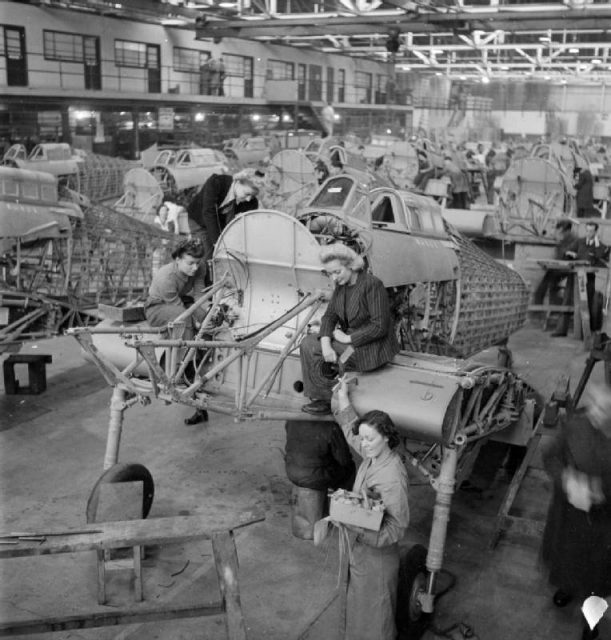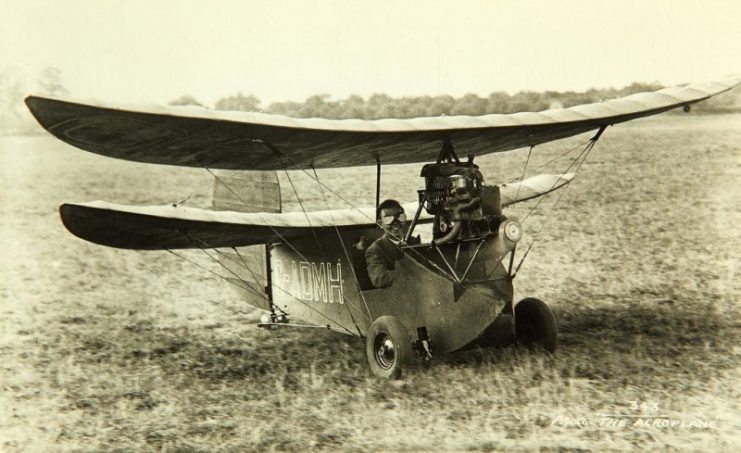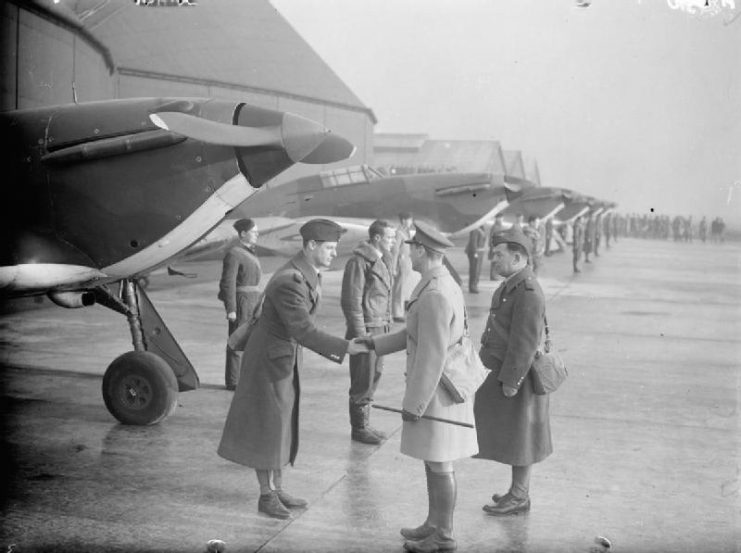The aircraft took off as a bi-plane, flew out over the sea with an RAF Hudson flying escort, jettisoned the upper wing, and returned to land safely at Squires Gate as a monoplane.
In the 1930s, most of the nations which would become combatants in World War Two made the transition from bi-plane to monoplane fighters. However, during the war, one enterprising company persuaded the UK Air Ministry to allow it to modify a Hurricane fighter by giving it an extra wing to turn it into a bi-plane.
The reasons to shift to monoplanes were compelling. Monoplanes were faster, partly because one wing produces less drag than two, but also because the thicker wing of a monoplane allows the use of a retractable undercarriage further reducing drag.
Monoplanes also had more firepower because the wings could be used to mount guns that fired outside the propeller arc.
However, a monoplane does have two distinct disadvantages over a bi-plane: it has higher take-off and landing speeds, and its single wing creates less lift making it slower to climb.

But, what if it were possible to combine the advantages of a monoplane with the short take-off and climb capability of a bi-plane? That was the notion that occurred to the designers at F. Hills and Son Ltd (usually known as Hillson), a light aircraft manufacturer based in the city of Manchester in England.
Hillson was a woodworking business. In 1935, it had purchased new and larger premises in Trafford Park in Manchester. The Managing Director, W.R. Chown, became interested in the possibility of manufacturing light aircraft.
Hillsons’ first product was a ‘Pou du Ciel’ HM.14 Flying Flea produced in late 1935. In 1937, they began volume production of the Hillson Praga, a license-built version of the Czech E.114 Praga two-seat, single-engine sports monoplane. Production of the Hillson Praga ended in 1939 when war was declared.

During 1940 and the Battle of Britain, Hillson became interested in the concept of a “Slip-Wing Fighter,” essentially a monoplane fighter fitted with a jettisonable additional upper wing. This would give the aircraft the short take-off and climb capability of a bi-plane as well as the speed of a monoplane once the extra wing had been jettisoned,.
The British Ministry of Defense was not interested but, undeterred, Hillson went ahead anyway. He designed and built a proof-of-concept prototype of what they called the Bi-Mono in just seven weeks.
https://youtu.be/CLc_b9wk4kk
The resulting aircraft was tiny – just 19 feet long and with a wingspan of 20 feet. It was constructed mainly of wood and powered by a de Havilland Gipsy engine, the same engine used in the Tiger Moth bi-plane.
The aircraft was designed as a low-wing monoplane, but it could be fitted with an additional upper wing supported on two sets of interplane struts which (just!) allowed the wing to clear the large cockpit.

When the prototype was completed, the Ministry of Defense became sufficiently interested to take over flight testing and the Bi-Mono (which was given the less dramatic Air Ministry designation Experimental Aeroplane N°133) was painted in Royal Airforce (RAF) markings and flown in both monoplane and bi-plane configuration from Barton airfield near Manchester in early 1941.
These tests were successful and, in July 1941, the aircraft was moved to Squires Gate Airport near the city of Blackpool for the first and only flight test of the wing-jettison mechanism.
Squires Gate was close to the sea, and this location was chosen so that the test could be carried out over water where there was no danger of the wing causing damage as it fell to earth.

The test worked – sort of. The aircraft took off as a bi-plane, flew out over the sea with an RAF Hudson flying escort, jettisoned the upper wing, and returned to land safely at Squires Gate as a monoplane.
The only issue was that the top speed as a bi-plane was considerably less than the stall speed as a monoplane. Consequently, when the upper wing was released, the aircraft dropped a fair distance before picking up enough airspeed to regain control.
However, the test was sufficiently impressive that the Air Ministry released to Hillson a very well-used Hurricane Mk I fighter on which to perform further experiments with the Slip-Wing concept.
The Hurricane which was provided to Hillson was one of a batch of 20 aircraft which had been sent to Canada in 1939 and then subsequently returned to the UK in 1940 where it served with RAF No. 1 Squadron.

Hillson built a second wing which was identical in size and aerofoil section to the Hurricane’s wing and mounted this on two N-section interplane struts so that it was well clear of the cockpit. The extra wing had no ailerons or other control surfaces and, like the upper wing on the Bi-Mono, could be jettisoned in flight.
The completed aircraft was formally designated the Hillson FH.40 but was widely known as the Slip-Wing Hurricane.
This odd-looking aircraft first flew in May 1943. Later, in September, it arrived at RAF Boscombe Down in Wiltshire in England where it was tested by the Aeroplane and Armament Experimental Establishment.
However, it appears that by the time the detailed testing of the FH.40 began, its intended purpose had changed. The RAF was less interested in a monoplane fighter with short-take off capability and was instead considering the additional upper wing for use as a giant fuel tank to allow a Hurricane to undertake very long ferry flights.
In this scenario, there would be no need for the mid-air jettison of the upper wing except in an emergency, and the flight testing focused on flying the aircraft in bi-plane configuration with no trials of the jettison procedure.

The performance of the FH.40 was found to be very poor. This is unsurprising considering that the extra wing, struts, and release gear added over 700 pounds to the weight of a standard Hurricane combined with the added drag of the upper wing.
As it turned out, the FH.40 proved to be the answer to a question that no-one was asking. Later marks of the Hurricane had improved short take-off and climb capability, so the complexity and cost of adding a jettisonable upper wing to a monoplane did not provide worthwhile benefits.

The potential use of the upper wing as a fuel tank would have required considerable work to strengthen the wing, the struts, and the release gear.
Read another story from us: The Hurricane: A Very Important Fighter in the Battle of Britain
As a result, the project was abandoned, and no more prototypes were produced. Hillson never made another aircraft. Instead, the company switched to producing wings for the Avro Anson and Airspeed Oxford aircraft and to producing laminated plywood for use in the construction of the Mosquito.
However, although it was ultimately a failure, the Slip-Wing Hurricane FH.40 remains one of the most quirky, imaginative, and distinctive British fighter aircraft experiments of World War Two.
